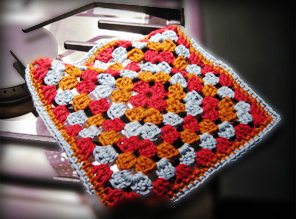Making a Granny Square Using the Turning Method

Eventually, almost all crocheters will make a project with granny squares. These beloved squares make very portable projects, use up yarn scraps and stash, and are infinitely variable. Most granny square patterns use theslip stitch method. I prefer the turning method. Crocheters who are not currently using this method can benefit from learning it and newcomers to the granny square will find it easier to master by learning this way.
When you use the slip stitch method, you slip stitch over to the corner chain space to begin the next round. When you use the turning method and turn at the end of row, a chain space is immediately to the left, next to be worked. No need for slip stitching over to it. Work the pattern as you normally would, crocheting 3 dc, ch 2, 3 dc in the corners and 3 dc in the the other chain spaces. The turning method also eliminates the lean or curve that granny squares tend to have with the slip stitch method.
For crocheters who want to eliminate slip stitches and the leaning effect, the turning method is a faster, better way to make granny squares.
